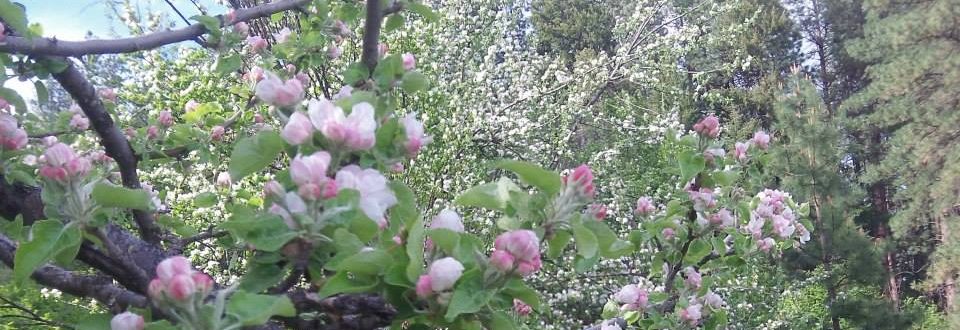The Ecological Trajectory of Homonids as Witnessed by the Genus Prunus
by Kyle Chamberlain
My preferred method for collecting sweet cherries is to climb the unkept wild trees, which often grow to thrilling heights. I feel distinctly primate in a cherry tree, swaying in the shimmering canopy, spitting seeds, hypnotized by birdsong. The smooth lustrous bark of cherry limbs make them uniquely climbable. The tiny ridges forming the fingerprints on the pads of my hands feel distinctly alive, doing what they evolved to do, providing traction for my three-dimensional locomotion. At these Northern latitudes, such excellent arboreal foraging opportunities are a rare treat.
Cherries belong to the stone-fruit genus, Prunus, which diverged from the the pome-fruit clade in the Eocene Epoch, 43 million years ago. This was around the same time the first true primates were evolving in North America and Eurasia. Fossil Eocene Prunus leaves have been found where I live, in the Okanagan Highlands of Washington and British Columbia. The world was a warmer, wetter place in the Eocene- lush forest covered every continent, extending even to the poles. Such a world might seem foreign us now, but the familiar cherry-gobbling primate evidences a certain continuity.
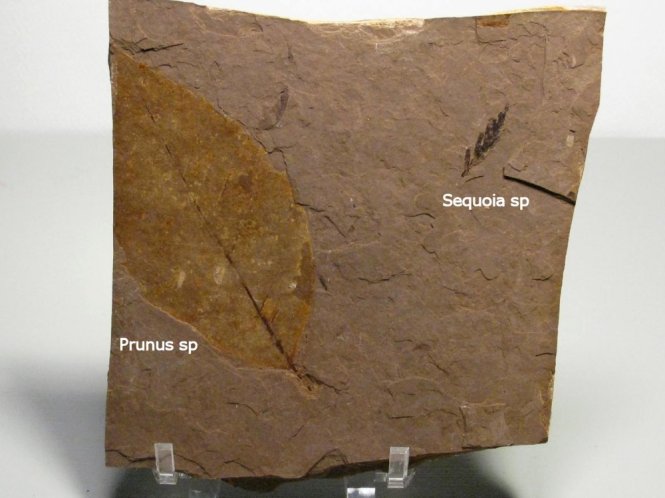
(Prunus sp., Eocene, McAbee Fossil Beds, Tranquille Shale, Cache Creek, British Columbia, Canada)
Prunus fruits, like cherries and plums, are staples of Northern orchards. These familiar trees follow seasonal rhythms which connect the temperate world. The sweet cherry trees thriving in my local ravines originated in Europe; they are well adapted to a climate of spring rains, summer heat, and winter snow.
But anthropogenic climate change is beginning to break up familiar seasonal patterns. And plant communities, always at the mercy of climate, will be changing rapidly as well. For a taste of future possibilities, I have looked South, first to California.
One key feature of climate is the seasonality of precipitation. Globally, the general pattern is that the Western edges of continents get most of their rain and snow in the winter (“Mediteranean” climates), and that the inland and Eastern areas of continents get most of their moisture in the summer (“continental” climates). This pattern tends to hold over geologic time, regardless of changing temperature. Since my home in Washington is on the West Coast, California is a logical place to explore how my home forests might adapt (or be adapted) to anticipated higher temperatures.
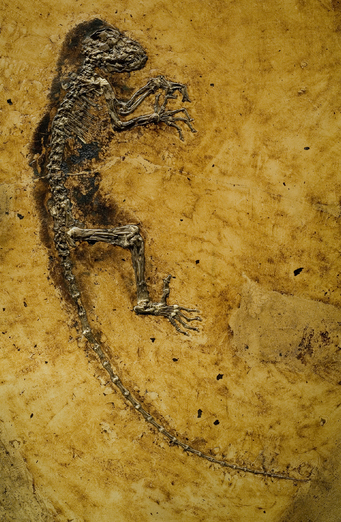
(Darwinius masillae, Eocene, Messel, Germany)
The native cherries of Washington and North are winter-deciduous. The common chokecherry is a good example. The chokecherry is the Northernmost cherry of our continent. Winter deciduousness makes particularly good sense in the far North (whatever the seasonality of precipitation) since there is little winter sunlight available for leaves to harvest. Many of our Northern tree species evolved in the arctic, which becomes totally dark in the winter. Further south, plants utilize other adaptations, which are more attuned to the seasonality of precipitation. Wide leaves become a liability when heat comes without rain. The broad-leaved trees of today’s Northwest Coast can get away with lush summer leafiness, because our dry summers are short and relatively cool.
But it hotter Mediterranean climates like California, leaves must be small, thick, and waxy, so as not to desiccate in the dry heat. Plants in such a climate also tend to be evergreen, retaining their leaves through the winter, when the moisture comes, and temperatures are mild enough for photosynthesis. Plants adapted in this way are called sclerophyllous. Sclerophyllous plants typify Californian chaparral and Mediterranean maquis shrub-lands. Forest trees of these regions also exhibit sclerophyllous traits.
The range of the deciduous chokecherry extends from Canada, down the Cascades, and into California’s Coast Ranges and Sierras. But the chaparral country, South of San Fransisco Bay, belongs to the sclerophyllous hollyleaf cherry, Prunus ilicifolia.
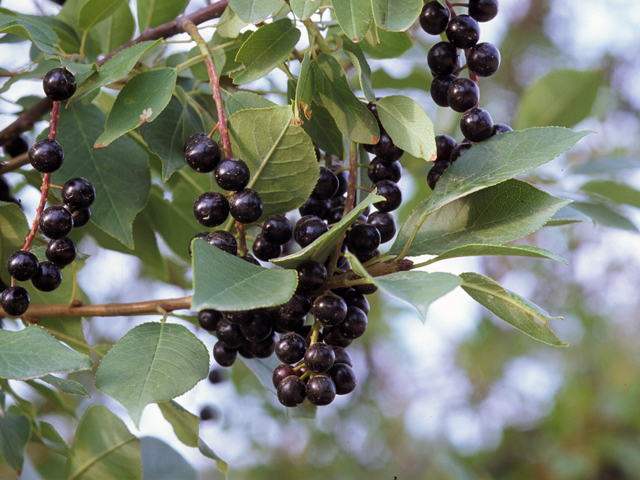 (Chokecherry, Prunus virginiana)
(Chokecherry, Prunus virginiana)
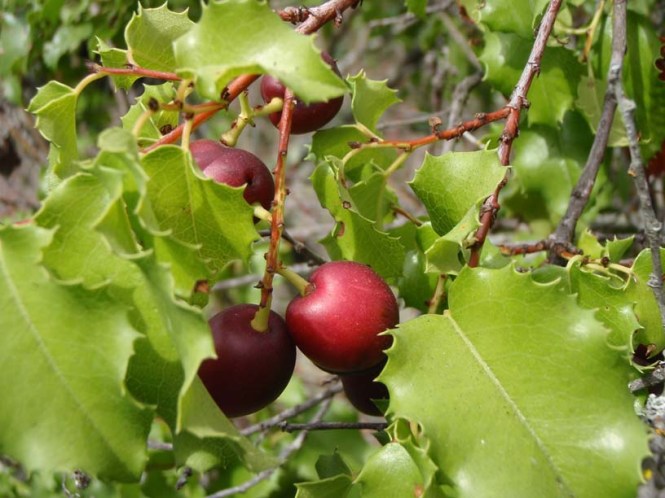 (Hollyleaf cherry, Prunus ilicifolia)
(Hollyleaf cherry, Prunus ilicifolia)
A Northerner might not recongize the hollyleaf cherry as a cherry at all. It’s leaves are truely holly-like- small, evergreen, thick, waxy, and spiny. Chaparal plants, slow to grow out of reach of herbivores, sometimes arm themselves with spines. Such plants may also employ aromatic antimicorbial compounds, aimed at thwarting herbivore gut flora. Even the fruit of the hollyleaf cherry fruit lacks lushness, being thin-fleshed and mostly seed. Most perplexingly, the fruit’s large seed was what indigenous people sought for food- not the flesh. The kernels of these cherries, toxic in raw form, were leached and prepared as mush. Large seeds, and sophisticated human uses for them, are characteristic of Mediterranean climates. The cherry, like human culture, nimbly adapts to diverse climactic situations.
In the grand evolutionary scheme of the things, the consumption of cherry pits, despite its dangers, would have been familiar to ancestral primates. The toxic compounds common to the seeds of all pome and stone fruits volatilize in the air, and can escape the body as a gas. Raw seed can be safely eaten, as long as the rate of consumption does not exceed the rate at which the body dispels the toxin. We count on this process when we consume almonds (Prunus dulcis). Simple methods of preparing cherry pits for food were used even in the North, where lush fruit is abundant. Chokecherries were crushed whole and dried by indigenous people, allowing the volatile toxin to dissipate in the air. Crushing and aging fruit is something that even tiny capuchin monkeys are known to do.
Hollyleaf cherry is a good example of how plant communities can adapt to the hot Mediterranean conditions which may soon claim more of Western North America. But in many places, particularly the inland, higher temperatures will amount to less available moisture. More land may become arid desert. Cool deserts may become hot deserts. The cherry genus can show us how to adapt to these conditions as well.
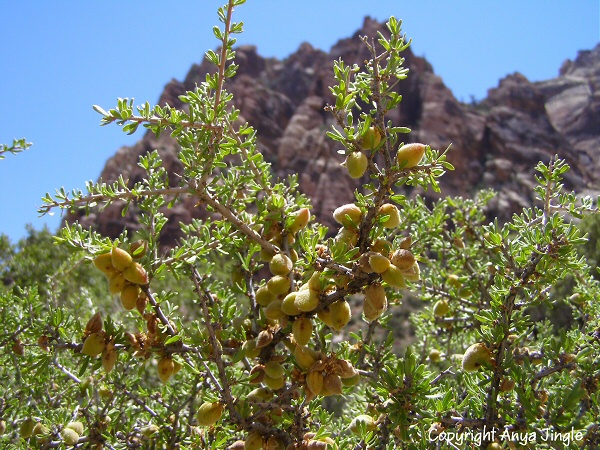 (Desert peach, Prunus fasiculata)
(Desert peach, Prunus fasiculata)
The desert peach, Prunus fasiculata is an even stranger cherry than its hollyleaf cousin. Even botanists initially placed this plant outside of the Prunus genus. Growing to the size and shape of your average sagebrush, the desert peach blends will into the vegetation of the Great Basin Desert. This Prunus has tiny spatulate leaves, and minute furry fruits quite unlike a luscious peach. Fuzz on plants helps reduce exposure to desiccating desert winds. Plants in deserts devote their energies to producing abundant small, dry seeds and fruits; there is plenty of bare ground to seed, to await the rain. The fruit of the desert peach, despite the fur, was once collected by desert dwellers for food, though the preparation techniques are forgotten, like so much of our desert survival knowledge.
In arid regions, winter rain encourages woody scrub, whereas summer rain can promote grasses and cacti. In the parts of the arid West where moisture comes in the winter, grasslands can exist where it is cool enough (in the North, or at higher altitudes). But these are unique cool-season bunchgrass type communities, and they are fragile. Warmer temperatures likely mean an expansion of desert scrub at the expense of grassland, particularly if inappropriate grazing practices continue. More of the West will belong to plants like the desert peach.
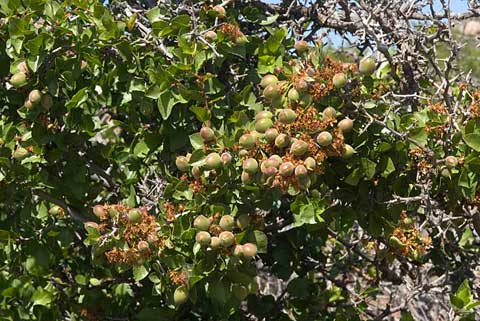 Desert apricot (Prunus fremontii)
Desert apricot (Prunus fremontii)
While the fuzzy desert peach is a creature of cooler deserts, the desert apricot, Prunus fremontii, prefers the hot desert of Baja California. It is possible that our cool deserts and steppes could transition to hot desert. Sagebrush, the iconic plant of the Intermountain West, may be on the retreat. Our sagebrush steppes are, in many ways, a remnant of the Ice Age, a kind of temperate tundra which took hold as the glaciers retreated. Sagebrush, incapable of re-sprouting after fire, has proven vulnerable to a new fire regime, fueled by exotic annual grasses. And as the temperature turns up, plants more attuned to fire and a Mediterranean climate will gain the upper hand. Much of what is now sagebrush steppe will become savanna, chaparral, or hot desert. We know a similar transition occurred in parts of post-glacial Europe.
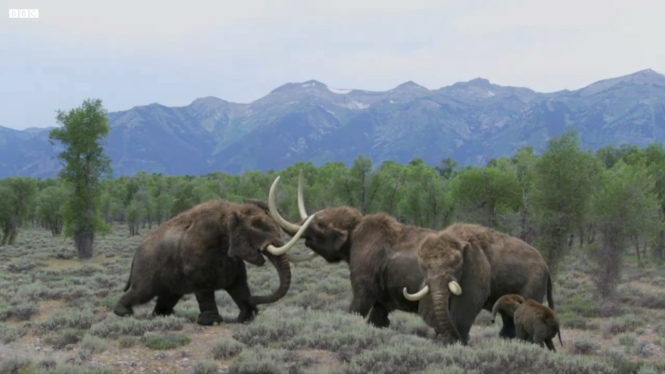
While sagebrush is pollinated and dispersed by wind, the plants warmer realms tend to rely an animal cooperation. The desert apricot’s substantial fruit is an example of plants catering to animals which help disperse seeds. Here also is an example of the underdog potential of New World food plants. Most Americans don’t know that a native apricot exists. But this fruit is, for all intents and purposes, an apricot like one you could buy in a bag. You probably didn’t know that that Western US has a native Klamath plum either.
There are a number of cultural and ecological reasons that native food plants have been marginalized. The legacy of colonialism and antagonism toward indigenous cultures are certainly major factors. Long cultural connections to these plants have simply been destroyed.
(Klamath plum, Prunus subcordata)
Another factor, which may explain the obscurity of the desert apricot, is prehistoric extinction. Many more of Eurasia’s large animals survived the Pliestocene extinctions, relative to North America. Without large animals, plants tend to adapt small fruits, fit for birds. The long-ago disappearance of large co-evolved dispersers probably diminished the distribution and quality of various native fruits.
It is also relevant that Eurasia has hosted hominins for millions of years, which must have favorably influenced the distribution and evolution of our favorite fruits. But the arrival of humans in North America, which may have caused our Pliestocene extinctions, was a relatively late and novel occurrence. And so many of our native fruits are small, obscure, unknown, and little developed.
But it’s possible, at some point, even the familiar domestic apricot only barely survived, eking out the Ice Age in some obscure Old World desert, until some friendly large omnivore spread its seed far and wide, selecting for the qualities we love today. Native plants have as much rich cultural potential as any of our imported species- and they are pre-adapted to place. The desert apricot and the Klamath plum are worth exploring. The teach us something about adaptation.
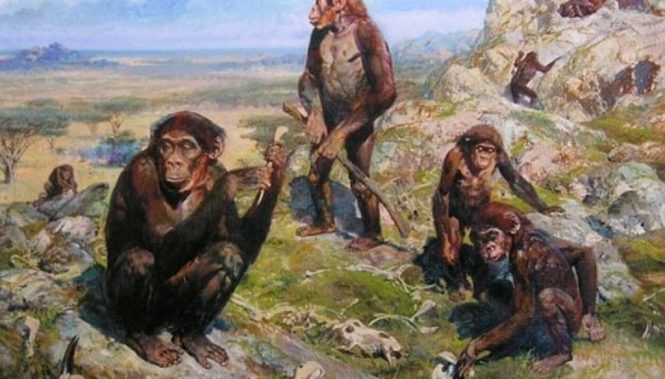
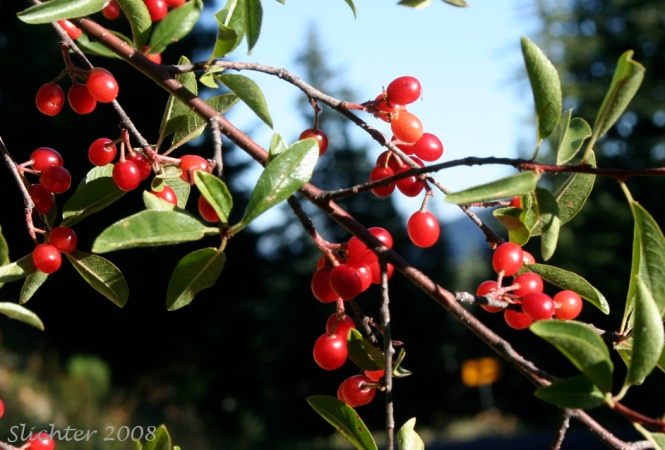 (Bitter cherry, Prunus emarginata)
(Bitter cherry, Prunus emarginata)
In the rainforests of the Northwest Coast, there is a native cherry, a deciduous cherry called the bitter cherry. This Prunus emarginata is so closely related to the domestic cherry that the two species sometimes naturally hybridize. The hybrid is called Prunus x pugetensis. Where this hybrid survives in nature, it we could perhaps regard it as an endemic taxon. The transfer of genes between the two species might help the cherry genus surive the uncertain future.
But if the rainforest gets warm enough, all kinds of deciduous plants will be at a disadvantage. Warming could bring about sub-tropical conditions. The iconic giant conifers of the Northwest coast could loose ground to heat-stress, fire, and pests. But what a sub-tropical Mediteranean rainforest looks like is something of a mystery. South of California there is the Baja Desert. South of the Mediterranean, there is the Sahara. These deserts exist because of atmospheric conditions specific to latitude, a phenomenon which is not likely to creep North. The flora of a warmer coastal forest is not within easy grasp.
Europeans looking for insight into a warmer, wetter Mediterranean past have looked to a tiny archipelago called Macaronesia, off the coast of Morocco. The flora of these islands is sometimes called the Madeiran Flora. Kept humid by the surrounding ocean, the Macaronesian Islands host a kind of forest called laurel forest (or laurisilva). Laurel forests are distinguished by trees belonging to the laurel family, as well as trees with attributes reminiscent of the laurels. Waxy, evergreen leaves with pointed tips help shed excess water during a downpour (wet leaves hamper transpiration). Another common adaptation involves aromatic herbivore-deterrent compounds. The laurel forest vegetation of Macaronesia closely resembles fossil plants from the Miocene Mediterranean.
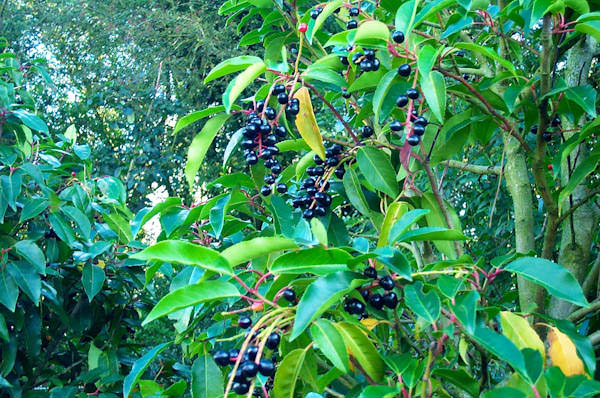 (Portugal laurel, Prunus lusitanica)
(Portugal laurel, Prunus lusitanica)
The Miocene Epoch defines a time toward the end of the warm wet Tertiary period, before a cooling and drying trend which culminated in the Ice Age. Our cherry-gobbling ancestors had become large omnivorous apes by then, and there were apes living in Europe. The Miocene is a reassuring reference point, because it accommodates apes (animals like ourselves) AND a high planetary temperature (not to mention a highly-mixed circumboreal distribution of plants, which makes our exotic weed problems seem trivial).
So, the apes gamboling around the Miocene Mediterranean (possibly our ancestors), lived in a laurel forest a lot like the forests of the Macaronesian Islands. And laurel forests have evergreen cherry species. In fact, one cherry, native to the relict laurel forests of the Mediteranean, looks so much like a laurel that it’s called the the Portugal laurel (Prunus lusitanica). A similar Mediterranean species, Prunus laurocerasus, the cherry laurel, has become invasive on the Northwest Coast, here in US. There is even a evergreen cherry native to the cloud forests of Africa, Prunus africana, which is a favorite food of gorillas. Whenever and wherever, in drastically different climates, there are primates gobbling cherries!
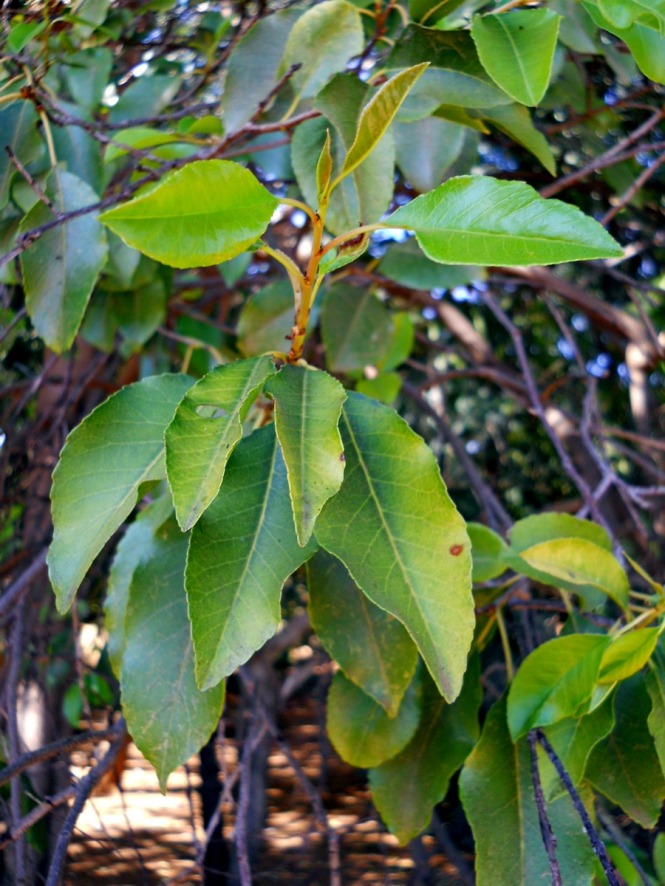 (African cherry, Prunus africana)
(African cherry, Prunus africana)
(Modern orangutans forage for mast in SE Asian forests of tropical tanoak and chinquapin, and there are cherry species in the nieghborhood too.)
Plant fossils from Miocene California also bear witness to laurel forest. This forest included extant California plants like the California bay laurel, madrone, tanoak, and evergreen oaks. The ancient forest also included trees related to avacado and sassafrass.
Leaf retention exhibited by “laurophyllous” plants is important in a hot climate. Rain may exceed what plants can immediately uptake, and rapid decay limits any water-retaining organic matter in the soil. The result is soil washed clean of essential minerals (becoming acid). Leaf retention is one way plants like laurels and rhodedendrons adapt to nutrient stress.
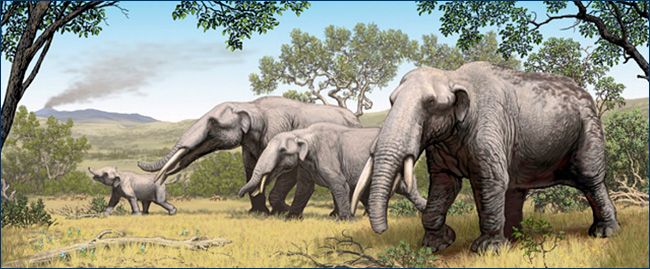 (Miocene California)
(Miocene California)
Leached soils, nutrient stress, and deep gullies were the planetary norm, until Ice Age glaciers churned up new earth, filled valleys with fertile deposits, and ground out the dust that settled a rich loess soils. Cold conditions allowed organic matter to accumulate in the soils of grasslands and seasonal forests- the soils that became our farmland. The vegetation’s capacity for weediness is still recovering from the cold spell. Our annual crops are losing the long-game, and can’t seem to evolve fast enough. Many of the conditions that make agriculture and civilization possible are the gifts of a colder time. Environmental degradation, aggravated by anthropogenic heat, are literally eroding these gifts away.
The cherry, and the ape, can survive a hot planet. But remains to be seen if Holocene civilization can adapt to the onslaught of geologic time.
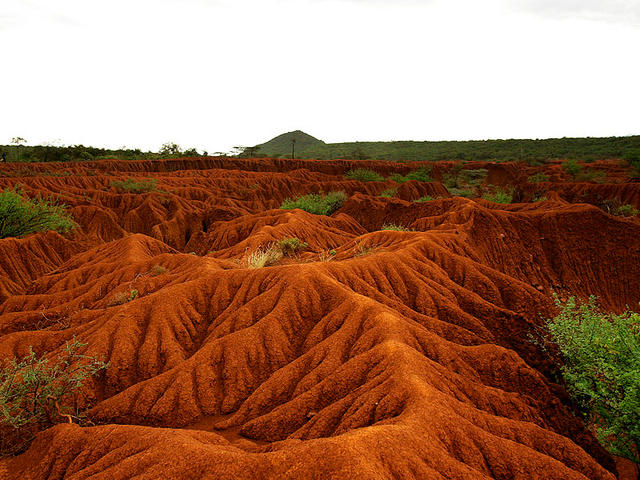
Links:
Miocene Germany
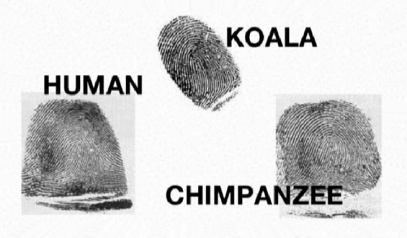 (“friction ridges” on the paws of arboreal mammals)
(“friction ridges” on the paws of arboreal mammals)
